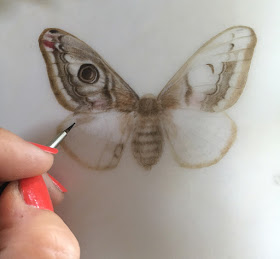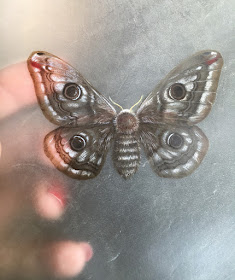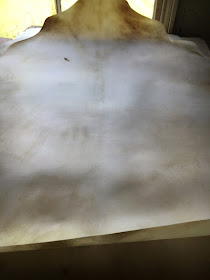Last Friday I visited the
William Cowley vellum and parchment works, in Newport Pagnall. I've been buying vellum from Cowleys for well over 10 years, so it was great to finally see how they make the calf skin vellum and to find out about some different types of vellum and parchment. I felt very honoured to be allowed in as they don't generally allow the public into their workshop. I left having purchased two beautiful skins, one of which was transparent vellum and the other a beautifully veined skin. I also selected lots of beautiful small cut pieces for workshops later this year. Only time will tell if I can produce decent work on the transparent vellum but I was reasonably pleased with my first attempt, an Emperor moth..... and enjoyed the challenge.
 |
| Trying out transparent vellum for the first time by painting a female Emperor Moth, Saturnia pavonia , a British resident moth and sole member of the Saturniidae Family in the UK. This vellum really is transparent but here it's laid on top of white paper yet still maintains a beautiful soft finish which differs from other vellum. The image appears to float on top of the surface giving a beautiful effect. |
 |
| Here you can see just how transparent this vellum really is! It takes a long time to produce such a piece of vellum with careful shaving of the skin until it's very thin, yet retains the subtle matkings. Cowley's only sell this in whole skins and it costs a little more than other types of vellum. I just had to take a skin to try and think it will be lovely for delicate white or lemon flowers, feathers and leaf skeletons etc. It can reversed for viewing and open mounted. I was told that calligraphers are able to write backwards on it for this purpose! |
 |
| The finished emperor moth, give or take a few tweaks. I may add a small piece of heather beneath the moth, which is one of its food plants. It's not particularly difficult to work on this vellum but it does require a very dry brush approach because the skin is thin, too much moisture would be likely to cause cockling. I used extremely fine stipple using a size 0 and 1 miniature brush on top of a light wash. I always avoid any outlining in order to maintain the soft edges. A small amount of titianium white watercolour was mixed into the light colours to accentuate the lights and to create the effect of the scales on the wings. |
|
|
 |
| Detail showing stipple which suits the effect of scales of the wing but this can also be smoothed with additional work if a softer finish is required. I worked using a x2.5 magnification to ensure the 'dots' were fine. |
The second skin that I purchased is a darker veined vellum, this came from Paul's favourites and is really stunning. More about the plans for that piece in a future blog post though.
A bit about Cowleys
There used to be 52 vellum and parchment makers in the UK but now
only Cowley's remains. The family business has been established since
the 1870's, started by William Cowley and continuing for 4 generations. Old photographs of the family can still be seen in the office today.
Cowley's recently they made the news headlines when the tradition of using parchment for documenting Acts of Parliament came under threat of being replaced by archival paper. However vellum won the day and the tradition continues. There can be no doubt that vellum will out live paper and this was evident when I viewed in the beautiful paintings on show at the Fitzwilliam Museum recently,see my previous post on the
Fitzwilliam.
Manager Paul went to great lengths to make me very
welcome, making lots of cups of tea and providing Black Jack and Fruit
Salad sweets! He had taken out a large number of skins for me to view in
advance and the store room was full of the rolled skins lined up on the shelves with scraps covering the floor. But he proceeded to bring down more and more skins until we got to the transparent vellum! The cut vellum was carefully stacked in different sizes and types. I haven't posted many of my photographs as Cowley's are quite protective of their business but there are lots on their website.
 |
| Choosing a skin, Paul explained about what we can learn about the life or death of the animal from its skin, by looking at markings and other clues. He can tell you if an animal died in the field, which side it fell on, the sex and the time of year it died. The honey vellum are summer skins and basically have a bit of a sun tan, whereas the winter skins are more marked or bruised often with dark hair follicles visible. |
Before I go any further I think it's important to
stress that no animals are killed specifically for vellum production, these animal skins would otherwise go to landfill so this makes good use of resources and continues the tradition, whilst providing artists and calligraphers with a wonderfully robust and beautiful surface suitable for paintings and illustrations. Vellum and parchment can last for over 500 years and in terms of provenance or authenticity ....well it has its own DNA and of course the unique markings, which make it impossible to copy.
Before I left I was allowed to try out the process of preparing the vellum, and tried my hand at shaving the skin smooth. This is a highly skilled craft and each skin is completely unique, the amount that the skin is shaved determines the final appearance, many look like works of art in their own right.
 |
| Preparing the vellum by shaving the surface whilst secured in a stretcher....it would take me a very long time to prepare a skin! |
The more I paint on vellum, the more tempted I am to completely abandon paper, no other surface matches it and given all of the problems with Fabriano papers it's becoming even more appealing.
When I left I signed the stretched skin at the entrance, which has been signed by other artists, calligraphers and film crews.
With a head bursting with ideas, I carried on my journey after leaving Cowley's and visited the wonderful Chelsea Flower show on the Saturday, so the vellum trial had to wait until I returned home on the Sunday. Ironically on the way home I received an email saying that my large Fritillaria imperialis ' Rubra' painting on Cowley's Kelmscott vellum had been accepted into the ASBA 19th Annual International Exhibition and will be shown at the New York Design Centre in November this year....so a good weekend all round!
 |
| Fritillaria imperialis 'Rubra' on Kelmscott vellum |








Dianne, you moth is awsome! there is a fine shade along the left side of the wing, lifting the moth of the surface - did you paint that or is it an effect of the transparent vellum?
ReplyDeleteGreat post Dianne! The transparent vellum looks wonderful!!!!!!
ReplyDeleteWow, it is so nice to see this and how you've handled this amazing substrate! I've always wanted to try it, but it is such a specialty and hard to find in the US. Looks like I'll have to plan a trip!
ReplyDeleteYour "attempt" at transparent vellum might well be a standard we novices try to emulate, for the effect of seeing a delicate and meticulous painting float and welcome the light is simply no less than magical. Truly lovely.
ReplyDeleteWow, I just love the moth - it looks as though it could fly away, absolutely superb! I definitely want to try vellum!
ReplyDeleteWow, for few seconds I thought it is realy butterfly but I was wrong. You have done neat and beautiful work here. Thank you for sharing the post with us
ReplyDelete